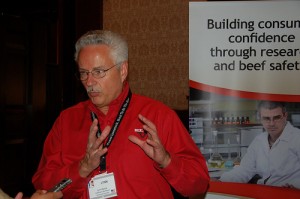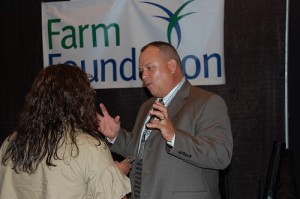 During the recent Ag Media Summit my friends at Gibbs & Soell conducted an “Ag Industry Pulse Check: Use of Digital and Social Media.” It’s a survey of attendees to gauge their feedback on the subject. To learn about the results I spoke with Gardner Hatch, who you can contact to get the full story.
During the recent Ag Media Summit my friends at Gibbs & Soell conducted an “Ag Industry Pulse Check: Use of Digital and Social Media.” It’s a survey of attendees to gauge their feedback on the subject. To learn about the results I spoke with Gardner Hatch, who you can contact to get the full story.
 It was very interesting to note that although over 94% expressed high levels of confidence with proposing the use of digital and social media, a high number (39.7%) said their top challenge was “unclear ROI to justify efforts.” So although they like and are comfortable with new media options they aren’t clear how to justify them. I think it’s interesting since these social media mechanisms are so “measurable.” However, there seems to me to be a lingering fear and or distrust of using measurements that don’t include all of a person’s demographic data. As if somehow, the visitors to a blog on agriculture aren’t farmers. Of course, some may not be but on the other hand why would you not think that visitors to a topical blog are involved or at least very interested in the subject?
It was very interesting to note that although over 94% expressed high levels of confidence with proposing the use of digital and social media, a high number (39.7%) said their top challenge was “unclear ROI to justify efforts.” So although they like and are comfortable with new media options they aren’t clear how to justify them. I think it’s interesting since these social media mechanisms are so “measurable.” However, there seems to me to be a lingering fear and or distrust of using measurements that don’t include all of a person’s demographic data. As if somehow, the visitors to a blog on agriculture aren’t farmers. Of course, some may not be but on the other hand why would you not think that visitors to a topical blog are involved or at least very interested in the subject?
Gibbs & Soell also had a drawing at the Ag Media Summit for a new iPod touch. The winner is Bob Callanan, American Soybean Association.
So, listen to my conversation with Gardner as he reviews the results of the survey and we discuss what they mean.
The ZimmCast is the official weekly podcast of AgWired. Subscribe so you can listen when and where you want. Just go to our Subscribe page.

 Looking ahead to the Farm Progress Show, there’s already a lot of activity on the site, including exhibitors. Take Monsanto for example. They’re not only busy but you can follow along since they have several web options.
Looking ahead to the Farm Progress Show, there’s already a lot of activity on the site, including exhibitors. Take Monsanto for example. They’re not only busy but you can follow along since they have several web options. Jim Evans,
Jim Evans, 



 “One of the things we’ve seen all summer with the economic situation, people have moved away from traditional steaks and those kinds of more expensive product. We’re working with retailers to help them feature those kinds of items. We’re helping consumers understand how to use something like the flatiron were they can still have the steak experience but at a lower cost.”
“One of the things we’ve seen all summer with the economic situation, people have moved away from traditional steaks and those kinds of more expensive product. We’re working with retailers to help them feature those kinds of items. We’re helping consumers understand how to use something like the flatiron were they can still have the steak experience but at a lower cost.” “A year ago when food prices were increasing and there were food riots around the world, we commissioned a study from three economists at Purdue on what are the real drivers to food prices. They reviewed literature, assessed the global demand for food and what were the driving factors including fuel, petroleum prices, world stocks, supplies of grain and more.”
“A year ago when food prices were increasing and there were food riots around the world, we commissioned a study from three economists at Purdue on what are the real drivers to food prices. They reviewed literature, assessed the global demand for food and what were the driving factors including fuel, petroleum prices, world stocks, supplies of grain and more.” Our photo album for the IFAJ Congress/Ag Media Summit has been giving us fits the last few days. Flickr is great but every once in a while . . .
Our photo album for the IFAJ Congress/Ag Media Summit has been giving us fits the last few days. Flickr is great but every once in a while . . .  Allen Moczygemba has been busy creating a new enterprise.
Allen Moczygemba has been busy creating a new enterprise. The results are in for the American Farmland Trust’s
The results are in for the American Farmland Trust’s  Peanut butter is one of my favorite foods. I’m also choosy enough to choose Jif. Now
Peanut butter is one of my favorite foods. I’m also choosy enough to choose Jif. Now